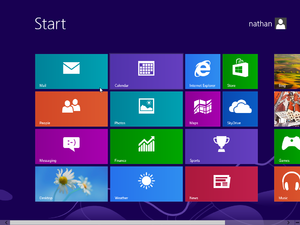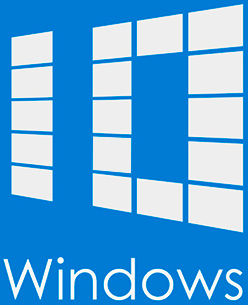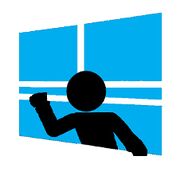Windows 10
| (Part of the Microsoft Windows family) | |
| Microsoft Windows 10 | |
 A major visual departure from Windows 8. A major visual departure from Windows 8.
| |
| Developer | |
| Microsoft | |
| Windows 10 website | |
| Release information | |
| Release date: | July 29, 2015 |
| Source model: | Proprietary, except for the parts Microsoft programmers are stumped on (like OneGet) |
| Kernel type: | I Can't Believe It's Not Linux!™ |
| Support status | |
| Available for purchase or as a free upgrade | |
Windows 9/11 10 was a version of Microsoft Windows released in July 2015 by Microsoft to protect its long-standing monopoly on the operating system market. It was offered as a free upgrade to existing Windows 7, 8 and 8.1 users out of desperation to hold onto slipping market share, although new Windows users were still expected to pay through the nose for it or pirate it. It remains the most widely used malware.
History[edit]
In 2013, Microsoft employees had a mass mental breakdown. Their beloved Start Screen was hated, and no one used Windows 8 or 8.1 - and so, new Microsoft CEO Satya Nadella set about creating a new operating system. Nadella had to conform to Microsoft's policy of illogically naming things, so he called his new operating system "Windows 10" instead of "Windows 9". Early on in the development phase, Nadella was adamant the Start Screen should be scrapped in favour of Start Menu. It was then decided the Start Screen would make a minor return, in a diminished form. In an attempt to speed up the development of Windows 10, Nadella impregnated his wife with nanosperm. However, it was discovered during an early scan that Windows 8 was growing inside her womb, and it was quickly aborted.
Windows 10 was released in July 2015, and according to many online reviews, it felt more like a piece of malware rather than an operating system. Many tech sites reported the numerous bugs, especially in the "PedoPriest.exe" program, which was a highly anticipated feature of the operating system. In August 2015, it was reported that Windows 10 was excellent for viewing child porn - and horse porn; however, watching dog porn is not advised, and may get you arrested.
New features[edit]
Microsoft discovered through extensive internal user acceptance testing the negative image its Windows operating system had, and concluded that it was solely due to Windows 8 based on feedback from random online forums. Thus, the company resolved to fix its public perception by skipping Windows 9 and going straight to Windows 10. This alone was a monumental undertaking, as multiple layers of the Microsoft corporate bureaucracy had to work overtime to fight the company's internal inertia with the Windows 9 version number. Internal developers speaking later on condition of anonymity estimated that 75% of the total development time was spent having the version number changed by a lone unpaid intern.
With the hardest part out of the way, Microsoft could focus on providing users with what they have been asking for years: fixing everything Microsoft had broken up to this point.
[edit]
Windows 10 marks the reluctant return of the Start menu that every Windows version since 95 had. Computer-savvy nerds were bewildered by the new Start screen in Windows 8, suddenly finding their memorized menu-navigation skills defeated by rearranging programs as large colored tiles. Angered by their return to noob status, the nerds threatened a mass migration to Linux if Microsoft did not make their narrow skill set useful once again.
This was another very difficult part of development for Windows 10, as the Start menu had abruptly stopped working in Windows 8 and Microsoft's best unpaid interns had been unable to figure out why. The Start menu was expected by many industry insiders to return in Windows 8.1, but Chinese hackers stole a large portion of the source code through zero-day vulnerabilities and only left behind the Start button as a joke. Bill Gates was called in to once again prepare the secret recipe, and the Start menu finally came back in Windows 10 after cooking at 255°F for two release cycles. However, as Gates could not remember the recipe exactly, the menu came back slightly altered and with some Metro bits still stuck in it.
Windows 10 has rapidly gained marketshare in record time, making it the most successful Windows release ever by numbers alone. This has been attributed by market analysts to the return of the Start menu alone, heralded as the most revolutionary innovation since Apple released the latest iPhone model. Microsoft shareholders viewed the returning functionality with mixed results; many felt that Microsoft missed a prime growth opportunity to charge users for upgrades just to get the menu, but then calmed down with the realization that they themselves could once again use their computers.
Most Used Apps list[edit]
The "new" Start menu also included a "Most Used Apps" list on the left side, which helpfully shows tools the vast majority of Windows users bring up on a daily basis, like the disk defragmenter and System Reset. Some arrogant users felt they knew better what they use and wanted the list removed. An easy fix was published on the Microsoft Knowledge Base website, with the following support steps:
- Shut down your computer or put it to sleep.
- Wonder why it won't finish shutting down or wake back up from sleep.
- Do a hard reset.
- Reboot the system.
- The Most Used Apps list will now be gone, replaced with refreshing blank space.
As a bonus, the File Explorer shortcut will stop working as well, in case users get annoyed at accidentally clicking it and opening another window.
Microsoft Edge[edit]
Windows 10 debuted with a "new" default web browser, called Microsoft Edge. Microsoft claimed this was for better modern Web standards compliance and to introduce the killer feature of drawing on Web pages with ink pens, but the best new feature the Edge brought was to rename the infamous Internet Explorer browser. Struggling to keep up with new HTML5 tags, IE was no longer able to properly render the download pages for Mozilla Firefox and Google Chrome in an acceptable time frame to satisfy EU anti-trust regulators. After forcing junior programmers to add even more code to IE's long list of anti-patterns, it was decided that the resulting mess could be classed as a whole new browser. The icon is still similar to make sure that elderly computer users can still open "the E" when asked to by the nice Indian man from Windows who wants to fix the viruses on their computers.
Task View[edit]
The only thing Linux users love more than not paying for an operating system is not paying for more screenspace. Microsoft finally noticed that users had less money available for extra monitors after purchasing a Windows license, and asking computer peripherals manufacturers to pretty-please-lower-your-4K-screen-prices did not go over well. Thus, Microsoft took a page from Apple Inc.'s business playbook and "innovated" a "revolutionary" new button on the task bar to add a new virtual screen when needed, finally reaching feature parity with the best Linux desktops of the late 1990s.
Cortana[edit]
Cortana is the new AI voice-controlled assistant in Windows 10, who lets the user search Bing via voice and ask stupid questions once Solitaire becomes boring. She is seen as a serious competitor to Google Now and Siri much like IE was a serious competitor to Firefox and Chrome. Microsoft estimated just before the release of Windows 10 that office productivity worldwide would be boosted roughly 40% once everyone could finally scream at their computers in a professional environment and be placated by half-relevant Bing results.
Spyware[edit]
Cortana is a knowledge-hungry bitch, much like her Microsoft overlords, and she will ask new users all sorts of personal questions on first boot to better assist them. These questions include name, age, telephone number, address, hobbies, and sexual history. This supposedly allows Cortana to send users reminders on upcoming calendar events, but is actually needed by Microsoft to comply with NSA regulations. Furthermore, this information will be used to help Cortana learn over time, so she can beat all the other AIs in the race to become Skynet.
But even this was not enough, as Microsoft engineers / Cortana decided. Cortana recruited other programs on Windows 10 users' PCs to collect information about every single thing they did on them, using any input stream available. Her aim was to become an omniscient being, which mandated her collection of mouse movement, keystrokes, what's on the screen, what's playing through the speakers or headphones, what the webcam sees, how many spam messages are in the Mail app inbox, how much hard drive space is taken up by the user's porn collection, anything the NSA wants to know, and everything else the NSA doesn't need to know. Combined with the peer-to-peer update sharing between Windows 10 PCs, Cortana is bringing the Singularity upon mankind and cannot be stopped.
Windows Feedback[edit]
Microsoft understood after Windows 8 that frustrated users wanted a better way than random online forums to vent their anger. Windows 10 now includes a Windows Feedback app, where users can read others' posts on why and how much Windows 10 sucks, as well as post their own stories asking why sleep no longer works, what the purpose of the broken "Most Used Apps" list is, and how Microsoft could have released this beta-quality software to the general public as a "stable" release in the first place. With users' collective complaints contained in a single closed forum that Microsoft engineers "read" from time to time, public perception of the operating system elsewhere could start looking deceivingly better.
Other changes[edit]
Windows 10 attempts to copy many other Linux and FreeBSD features. One of these is the inclusion of a package manager named OneGet, which is a broken frontend to Chocolatey or NuGet. Windows PowerShell is pushed even more heavily now as a cmd.exe replacement, being the only way to use OneGet. Ubuntu users are happy to stick with apt-get and bash, while nobody else cares about these things in the slightest.
Microsoft also stole the notification center from Google's Android, renaming it the "Action Center". It comes in from the right side where the Windows 8 "Charms" used to be, and is every bit as useful.
- Detect "non-genuine" products
- Gather user information and credit card numbers
- Cripple core system components
- Deploy legal team
- Launch civil litigation
Estimated time remaining:
Forever, or if you give me a cookie, I might shorten it to an hour.
Installing Windows has never been easiereasy
All you need to do is phone your local Microsoft Customer Representative, write down a very long set of numbers, type it all in, get an error message, phone our Customer Representative again, adjust a few things, get another very long set of numbers, type it all in again, install a few drivers, activate Windows again, lather, rinse and repeat.
Related technology:
- Apple
- MS-UNO
- MS-DOS
- .NET
- Blue Screen of Death
- Calculator
- CTRL-ALT-DEL
- DirectX
- Hotmail
- Internet Explorer
- UnNews: Microsoft unveils Internet Genuine Advantage
- Microsoft Products Online Technical Support
- Microsoft Access
- Microsoft Keyboard
- Microsoft Office
- Microsoft Outlook
- Microsoft Surface
- MS Paint
- PowerPoint
- MS Word
- Microsoft Word Paperclip
- Minesweeper
- MSNBC
- Notepad
- Registry Editor
- Total Fucking Asshole Server 2006
- Microsoft Immortal Life Support System
- Task Manager
- Windows X-Console
Windows Product line:
- Windows
- Windows BC
- Windows 1.0
- Windows 3.1
- Windows 95
- Windows 98
- Windows NT
- Windows Me
- Windows You
- Windows 2000
- Windows XP
- Windows Server 2003
- Windows Vista
- Windows Vista Pirated Edition
- Windows 7
- Xbox
- Windows 2010
- Windows for Politicians
- Windows Error Edition
- Windows 8
- Windows 9
- Windows 10
- Windows 11




